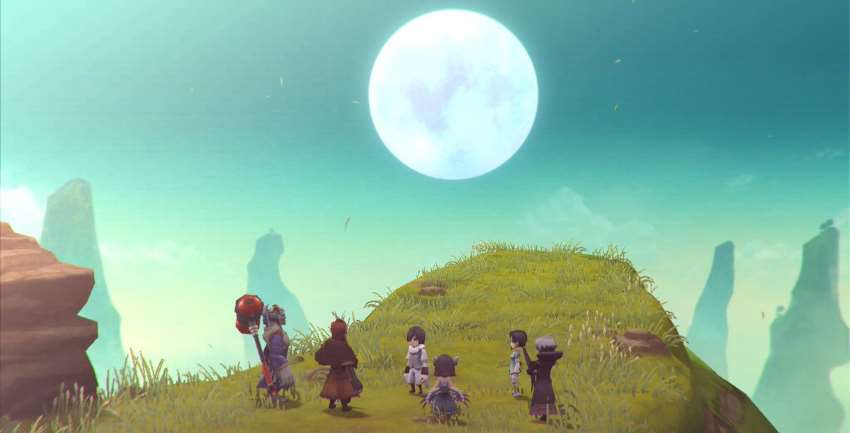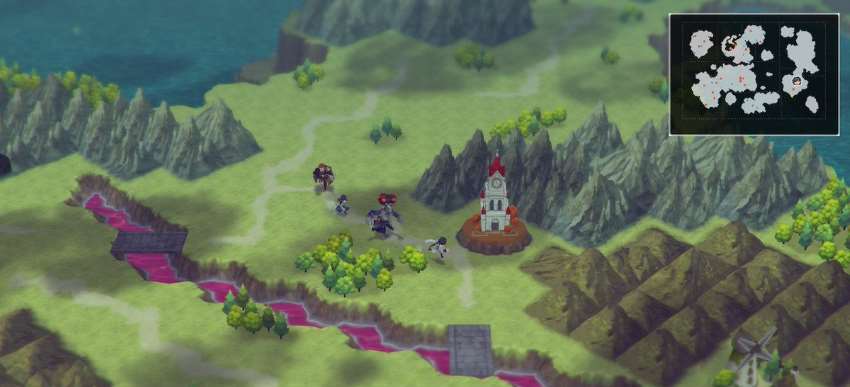Game Log: Lost Sphear

Perhaps my expectations for Lost Sphear were a bit too high. Not to begin by giving the impression I disliked the game. I am actually quite looking forward to whatever Tokyo RPG Factory is next tinkering on… supposing Lost Sphear’s Western sales were to Square Enix’s liking.
It seems I was a bit of an outlier in my love for I Am Setsuna. Despite the flaws of its systems I really enjoyed what it did with its story. Popular opinion seems to be colder due to the gameplay not capturing the same je ne sais quoi of obvious inspiration Chrono Trigger. Such frozen reception means not many were looking forward to the follow-up, whereas my experience with I Am Setsuna turned Lost Sphear into a must-play of 2018.
Odds are the fifty-dollar price-tag helped wipe away any potential salivating customers. Lost Sphear may be a longer experience than its predecessor, making use of a far greater variety of environmental and character assets, but something about its presentation gives the impression of “cheapness”, I suppose. On the surface there’s no explicable reason why a smaller budget game like Octopath Traveler can surpass one-million units while Lost Sphear sits in wishlists for a sale. The first assumption to surface may be that Octopath Traveler’s visual aesthetic is so reminiscent and spot-on of Final Fantasy VI that it parasitically sinks its teeth into whatever part of our brains craves nostalgia. Digging into questions I rose regarding I Am Setsuna’s own presentation, I wonder if it may be the more satisfying and visceral presentation of defense-shattering animations.
Or it could simply be a matter of mechanics. Demos for both Lost Sphear and Octopath Traveler were made available, and the tactical hook of Boost Points and enemy vulnerabilities are immediately clear and engaging to the player. Lost Sphear, on the other hand, feels more straight-forward as a demo and fails to address the thick opacity of its predecessors deeper mechanics.
I Am Setsuna was in need of some major revisions. Lost Sphear made a few tweaks and adjustments, but it failed to trim the fat and clean the clutter. Tokyo RPG Factory needed to figure out what worked and what didn’t, abandoning distractions so that they might improve and expand upon what captivated players. Momentum Mode was not a bad concept, and even worked in a similar fashion to BP in Bravely Default or Octopath Traveler. A sort of special move that you build your combat strategy around in order to get the most out of your abilities. In order to actually use Momentum Mode with your combat abilities, you must have a Momentum Spritnite attached to that skill. Even if the character has permanently attached ten new effects to that move, they’ll be worthless without a Momentum Spritnite attached.

Which perhaps is a bit deep in the dirt regarding how it works. Nevertheless, managing what’s equipped is where the real strategy is. Think of it as having two separate categories of Materia from Final Fantasy VII. You have your abilities, like Kanata’s “Cyclone”, and then you have Momentum Spritnite that may add fire damage to the attack once Momentum is activated. As the game progresses you’ll be able to purchase Momentum Spritnite that can inflict poison, paralysis, silence, and similar effects upon the foe. Or successful execution of a Momentum strike can restore health to each member of the party. Perhaps you’d like that Area-of-Effect attack to also boost the party’s defense? Or weaken the foe’s magic defenses?
Stacking these abilities also goes hand-in-hand with creating Artifacts upon the world map. As the player adventures across the world they’ll obtain a variety of Memories which can be used to place structures across the landscape. The effects vary greatly, but many of them help boost the rate at which Momentum or Turn gauges increase. At times they’ll even reset the enemy’s turn gauge! There’s a whole host of effects that can increase the player’s combat proficiency, and it’s very easy to find yourself benefiting from even ignorantly made decisions.
Unfortunately, this is also where we stumble upon the problem of in-game economy. Pennies are thoroughly pinched as the player prays for a substantial drop of gold after combat. Colored Spritnite are available for upgrading equipment, but they beg the question of why upgrade equipment when it is so expensive. The player recoups no costs spent investing in gear improvement, and simple upgrades may end up costing twice or thrice the money of gear through the next few towns and dungeons. The player will temporarily be over-powered, but by the time they start feeling the heat their pockets will still be famished for cash.
New Spritnite for abilities and Momentum are purchased with Memories, which are fortunately not tied to elemental and type kills as the materials in I Am Setsuna had been. Nevertheless, even players familiar with the preceding game may be ill-prepared to properly outfit their party with an advantageous moveset due to a lack of necessary Memories required for a purchase. Many end-game Spritnite require Memories only obtained in early parts of the game, territories the game gives little to no reason to return to.
This means even a half-optimal build for your party requires some level of back-tracking and grinding. A grind that yields no additional benefit in regards to experience gained or money earned. This is nothing to say of the time spent diving into the game’s Codex, first figuring out which creatures drop that type of Memory – assuming that foe has already dropped it in your past ventures, otherwise it remains unlisted – and then cross-referencing with where in the world that enemy is located.
Rather than fixing the flaws in I Am Setsuna’s systems, they exchanged old wrenches in the gears for brand new ones.

I don’t mean to give the impression that the game is an endless series of frustrating circumstances. I am only as disappointed as I am because the moments where it works are quite satisfying. Several boss battles started with a rough series of buffs, heals, and gentle pokes before Momentum had built, and towards the end of the game especially the player is capable of having near-limitless Momentum charges at their disposal with swiftly filling turn gauges. It was not unheard of for me to have such a fusion of boons from Artifacts and my Momentum attacks that a boss would act no more than twice or thrice in a single engagement. It’s just exhausting sometimes having to even have a halfway decent loadout rather than feeling like a true master of the mechanics.
I was similarly disappointed in I Am Setsuna, but I greatly found myself invested in that game’s narrative themes and character arcs. Lost Sphear, by contrast, seems to have traded that smaller-scale, personal story for the sake of a more typical sprawling epic. True, even I Am Setsuna proved to have the fate of the world hanging in the balance by the end, but Lost Sphear loses that same heart and consistency in theme. If I had to argue what Lost Sphear was about, it would be a less confident belief that it puts forward the notion that history and violence repeat, but it’s still worth fighting, or that what matters is what is worth fighting for.
Nothing as potentially poignant as asking what a life is worth.
Of course, it also wouldn’t surprise me if the vast majority of players thought Lost Sphear’s narrative was a significant improvement. It hits all the typical notes of an epic JRPG tale, yet it simultaneously feels better executed than its Bravely Default brethren. Yes, there’s a big and oppressive Empire, but they never feel like the Star Wars rip-off so many are.
Regardless, while Lost Sphear is an imperfect, flawed game, I still heartily recommend it to fans of the genre. I especially recommend it to those that would perhaps look more fondly on it if they imagined it as some quirky, lesser-known role-playing game on the original PlayStation. Aside from the graphics having a similar, albeit improved, aesthetic, the game overall has that sort of quality about it.
In the meantime, I’ll be hoping Tokyo RPG Factory continues to work on more games. Square Enix has not announced the studio’s closure, so I’m assuming they are hard at work to prove themselves worthy of their mission statement: to craft a title that lovingly calls to fans of the 90’s era of role-playing games. While it seems Octopath Traveler may have beaten them to it, I think Tokyo RPG Factory has the capability of putting out something truly spectacular. They just need to spend a lot of time getting the game’s mechanics right.


